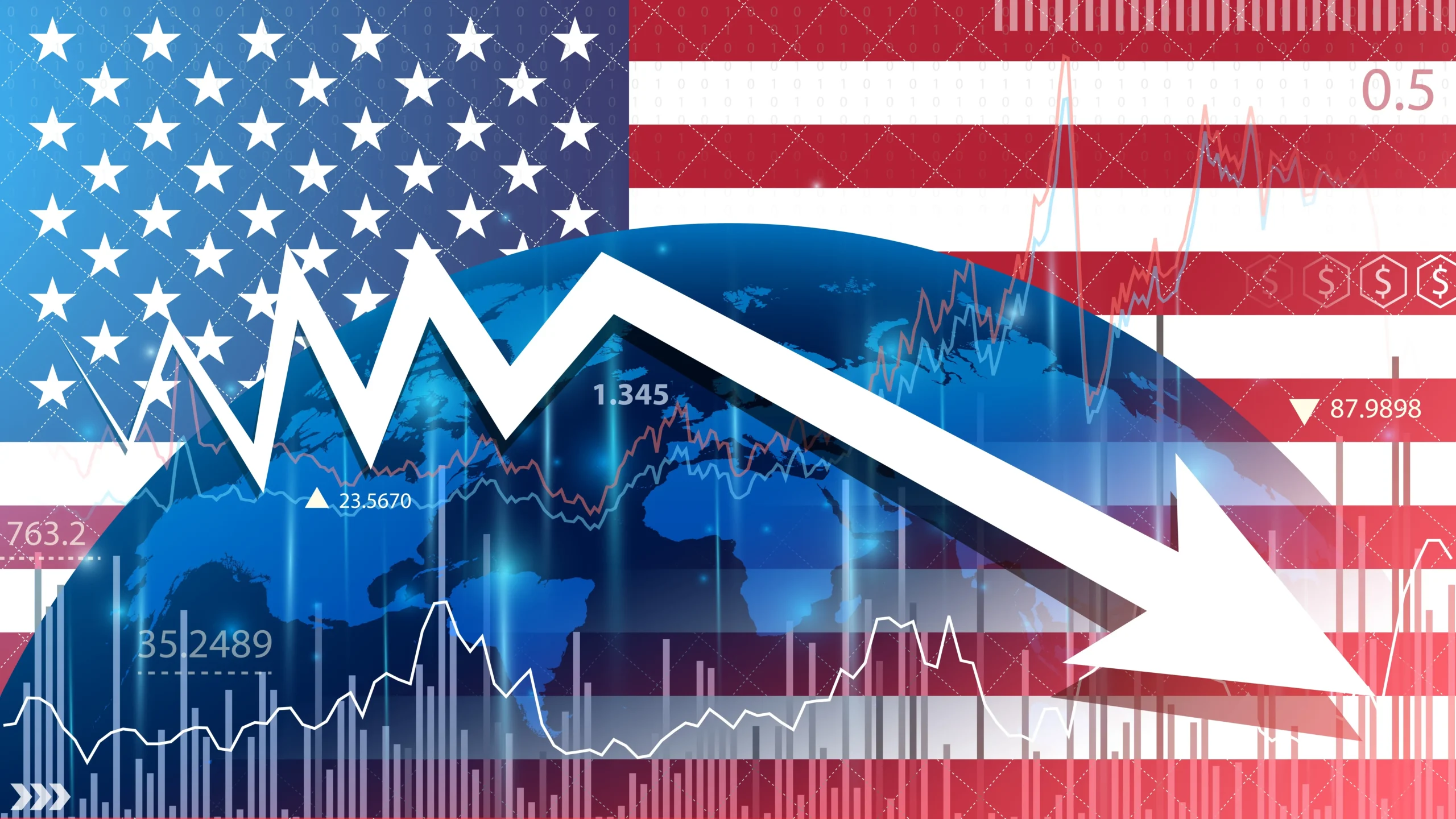This analysis provides a comprehensive analysis of the United States economy as of November 2025, addressing the query of whether its current status is one of a "boom" or a "downslide." The principal finding is that the economy is exhibiting clear signs of downsliding in the immediate term. This assessment is substantiated by a pronounced deceleration in the labor market and a pre-emptive, counter-inflationary interest rate cut by the Federal Reserve, which has explicitly prioritized mounting employment risks over persistent inflation.
The 2025 economy is uniquely defined by the simultaneous implementation of two contradictory, multi-trillion-dollar policies. This has created a state of extreme tension and volatility:
A Contractionary Trade Shock: A new, aggressive tariff regime has been implemented, acting as a significant, broad-based tax on imported goods. This policy is demonstrably raising prices, eroding household purchasing power, and creating a drag on economic activity.
An Expansionary Fiscal Stimulus: The "One Big Beautiful Bill Act" (OBBBA) was passed, enacting a massive, deficit-financed stimulus by extending the 2017 tax cuts. This policy is designed to boost demand and investment.
The current "downsliding" dynamic is a direct result of the tariff shock's immediate contractionary impact, which has, for now, overpowered the stimulus. The Federal Reserve's October 2025 decision to cut interest rates confirms its judgment that "downside risks to employment" constitute the most immediate threat.
This analysisU.S. forecasts a volatile and unstable path. The 2025 slowdown is expected to give way to a temporary, stimulus-fueled "sugar high" in 2026, as the OBBBA tax cuts take full effect and boost demand. This artificial boom is projected to fade quickly by 2027-2028, revealing an economy structurally strained by a gross national debt exceeding $38 trillion, a persistent $1.8 trillion annual deficit, and a deteriorating net international investment position of -$26.14 trillion. The new policy mix has locked in this structural weakness.
Current Economic Status (2025): A Picture of Contradiction
An analysis of real-time macroeconomic indicators for 2025 reveals a volatile and weakening economy, were positive headline figures mask significant underlying fragility.
Real GDP: The Q1 Contraction and Q2 Rebound
The U.S. economy began 2025 with a negative shock. Real GDP decreased at an annual rate of 0.6% in the first quarter, signaling a significant stall. This was followed by a sharp, seemingly “booming” rebound in the second quarter, with real GDP increasing at an annualized rate of 3.8%.
However, a deeper analysis of the Bureau of Economic Analysis (BEA) data shows this rebound is a statistical anomaly, not a sign of robust health. The BEA’s official release states the 3.8% increase “primarily reflected a decrease in imports, which are a subtraction in the calculation of GDP, and an increase in consumer spending”.
This distinction is critical. GDP is calculated as Consumption + Investment + Government Spending + (Exports – Imports). When imports fall, the (Exports – Imports) term becomes less negative, mathematically increasing the final GDP calculation. But a sharp fall in imports is not an economic strength; it is a sign of a weakening domestic demand. Consumers and businesses, facing higher prices from new tariffs, are reducing their purchases of foreign goods. This weakness is consistent with the negative Q1 GDP print and the Congressional Budget Office’s (CBO) analysis that new tariffs are “eroding the purchasing power of households.” Therefore, the “booming” 3.8% Q2 GDP figure is misleading; it paradoxically confirms the “downsliding” pressure on the U.S. economy.
The Labor Market: Slowing Growth and the 4.3% Unemployment Plateau
The labor market provides the clearest evidence of an economic slowdown. Job creation has decelerated sharply throughout 2025.
Total payroll job growth averaged 55,000 per month in the second quarter of 2025 and slowed further to an average of 51,000 per month in the first two months of the third quarter. The August 2025 employment report showed a near-stall, with only +22,000 jobs created. This is a dramatic slowdown from the 73,000 jobs per month that forecasters had been predicting for the current quarter.
The unemployment rate has ticked up in response. After fluctuating between 4.0% and 4.2% from May 2024 to July 2025, the unemployment rate rose to 4.3% in August 2025. This is just below the CBO’s 4.4% estimate of the “non-cyclical” (or natural) rate of unemployment. This stall in job creation is a major red flag, indicating that businesses are pausing hiring in response to rising costs from tariffs and slowing consumer demand.
The Inflation Trajectory: Core Moderation vs. Tariff-Driven Price Pressures
The inflation picture is highly complex, as the tail end of the 2022-2024 disinflation period collides with new, policy-driven price shocks.
The Moderation Narrative: On an annual basis, Consumer Price Index (CPI) growth has moderated. From January to September 2025, CPI growth ran at a 2.5% annual rate. The 12-month rate as of September 2025 was 3.0%. In a positive sign for core inflation, rent of housing inflation has slowed to 3.7% over the year, its slowest pace since December 2021.
The New Pressure Narrative: This moderation is being actively threatened by the new policy mix. Energy prices (specifically gasoline) and food prices (both at-home and away-from-home) accelerated in the third quarter of 2025. Non-housing core services inflation also picked up. These new pressures are consistent with the inflationary impact of both the OBBBA tax cuts (boosting demand) and the new tariffs (a direct cost-push shock).
The Federal Reserve's Pivot: Prioritizing Employment Over Inflation
The single most important data point for assessing the 2025 economy is the Federal Reserve’s recent policy action. On Oct. 29, 2025, the Federal Open Market Committee (FOMC) cut the federal funds rate by 25 basis points, lowering its target range to 3.75% – 4.00%. This was the second consecutive rate cut, following a similar 25-basis-point reduction in September. This action is highly significant. A rate cut when 12-month inflation is at 3.0% —well above the Fed’s 2% target—and when the government is implementing new inflationary policies (tariffs and deficit-financed tax cuts) is a profound statement.
The Fed’s official statement provided the explicit rationale: “Job gains have slowed… and the unemployment rate has edged up… Inflation has moved up… and remains somewhat elevated.” Crucially, the Committee concluded that “downside risks to employment rose in recent months.” Outside analysis concurs: the Fed “lowered the federal funds rate… in response to growing evidence that the labor market is weakening”, and policymakers “now see greater risk in a cooling job market than in rising prices.” The Federal Reserve, with access to all available data, has effectively concluded that the “downsliding” risk (recession, job losses) posed by the current environment is a more credible and immediate threat than the “booming” risk (overheating, inflation).
The Twin Pillars of 2025 Economic Policy
The 2025 economy’s contradictory performance is a direct result of two dominant, oppositional policies enacted by the administration. The economy is currently functioning as a battlefield between a massive fiscal stimulus and an equally massive trade-based tax hike.
Fiscal Policy: The “One Big Beautiful Bill Act” (OBBBA) (P.L. 119-21)
The OBBBA (Public Law 119-21) is a massive, expansionary fiscal stimulus enacted via the budget reconciliation process.
Policy Description: Its primary function was to prevent the “tax cliffs” by making permanent or extending many of the 2017 Tax Cuts and Jobs Act (TCJA) provisions. This included the lower individual tax rates and brackets. It also extended business-friendly policies like bonus depreciation and modified others related to pass-through deductions and business losses.
Fiscal Impact (The Stimulus): This legislation is financed entirely by borrowing. The CBO estimates the OBBBA will increase the federal deficit by $3.4 trillion over the 2025-2034 period. Factoring in $718 billion in additional debt-service (interest) costs, the total impact is an increase to the national debt of $4.1 trillion. This cost could climb to $5.5 trillion if other temporary provisions are also extended without offsets.
Distributional Impact: The benefits of this stimulus are not evenly distributed. CBO’s analysis shows the law’s benefits are heavily skewed toward higher-income households. When combined with the new tariffs (which act as a regressive consumption tax), the net effect of the 2025 policies is a reduction in after-tax-and-transfer income for every income group except the top decile. Households in the bottom 10% are projected to see an average income reduction of 7%.
Trade Policy: The 2025 Tariff Regime
Operating in direct opposition to the OBBBA is a new, contractionary trade policy that acts as a direct tax on imports and U.S. businesses.
Policy Description: The administration imposed a minimum 10% tariff on all U.S. imports, with higher rates on specific countries. Despite a recent 10-percentage-point cut following a summit with Xi Jinping, tariffs on Chinese goods average 47%. Other allies face high rates, including 35% on Canada and 39% on Switzerland.
Fiscal Impact (The “Tax Hike”): In a near-perfect fiscal offset to the OBBBA, the CBO estimates the new tariffs (implemented from January to August 2025) will decrease the primary deficit by $3.3 trillion over the 2025-2035 period. Including $0.7 trillion in interest savings (from lower borrowing), the total deficit reduction is $4.0 trillion. This revenue stream is already materializing; customs duties in July 2025 rose 252% year-over-year.
Macroeconomic Impact: This $4.0 trillion in revenue is not “free”; it is extracted from the private sector. The CBO states these tariffs are the primary driver of the 2025 economic slowdown, as they “raise prices… eroding the purchasing power of households.” Independent modeling supports this: the Yale Budget Lab estimates the tariffs will persistently shrink the U.S. economy by 0.6% in the long run ($160 billion annually), while the Penn Wharton Budget Model (PWBM) projects a more severe 6% long-run reduction in GDP.
The central contradiction of 2025 is this: the administration is simultaneously executing a $4.1 trillion stimulus and a $4.0 trillion tax hike. These do not “net out.” One policy (OBBBA) is designed to boost demand, while the other (tariffs) is designed to constrain supply chains and reduce demand via higher prices. The 2025 economy is caught in this policy war. As confirmed by the Fed’s rate cut, the contractionary “strangulation” effect of the tariffs is, for now, winning.
The Federal Budget and National Deb
The 2025 fiscal situation continues the trend of structural deficits and accelerating debt seen over the past decade, a trend now locked in by the OBBBA.
The FY2025 Budget Deficit: Deconstructing the $1.8 Trillion Shortfall
For the fiscal year ending Sept. 30, 2025, the federal government ran a deficit of $1.78 trillion, according to the U.S. Treasury. The CBO’s estimate is similar at $1.8 trillion. This is effectively unchanged from the FY2024 deficit of ~$1.82 trillion.
This deficit is the result of competing forces:
Revenues: Total revenues for FY2025 were $5.23 trillion, an increase of 6% over FY2024. The CBO notes this increase was driven by “collections of individual income taxes and customs duties” (i.e., the new tariffs).
Outlays: Total spending was $7.01 trillion, an increase of 4-5%. This growth was driven by mandatory spending programs (Social Security, Medicare) and, most notably, rising “net interest on the public debt”.
The National Debt Trajectory: Breaching $38 Trillion
As a result of these persistent deficits, the Total Public Debt Outstanding (Gross National Debt) reached $38.04 trillion as of Nov. 3, 2025.This total is comprised of $30.57 trillion in Debt Held by the Public and $7.44 trillion in Intragovernmental Holdings.
The debt’s acceleration is stark. It stood at $37.64 trillion September 30, 2025, and $35.46 trillion on Sept. 30, 2024.This represents an increase of $2.17 trillion in a single year.
Historical Context: Comparing Deficit and Debt (2005-2025)
The FY2025 deficit is not an anomaly but part of a new, structurally weaker fiscal regime.
Trump 1st Term (FY 2017-2020): This period was defined by the 2017 TCJA. In a strong, expanding economy, deficits rose—a highly pro-cyclical policy. The deficit grew from -$665 billion (FY17) to -$984 billion (FY19) before the pandemic. The pandemic response then caused the deficit to explode to –$3.13 trillion in FY2020.
Biden Administration (FY 2021-2024): This era began with the largest deficit since WWII (FY21: -$2.78 trillion) due to pandemic-relief spending. As spending wound down, deficits fell to -$1.38 trillion in FY22 but then rose again to -$1.70 trillion in FY23 and -$1.82 trillion in FY24.
Analysis: The FY2025 deficit of $1.8 trillion 11 is not a “COVID” deficit. It confirms a new structural normal for the U.S. budget. The annual shortfall has settled in a $1.7-$1.8 trillion range, nearly double the pre-pandemic (FY19) deficit of $984 billion.The OBBBA’s $4.1 trillion in new, long-term deficit-financed tax cuts ensures this high-deficit regime will continue.
The External Sector and Foreign Trade
The external sector data reflects the same policy contradictions as the domestic economy. The administration’s tariff-driven pursuit of a smaller trade deficit is, in the short term, being “achieved” only by signaling a domestic economic slowdown.
The U.S. Current Account and Trade Deficit
The data on trade flows has been extremely volatile in 2025. In the second quarter of 2025, the U.S. current-account deficit narrowed dramatically by 42.9%. It fell from a revised -$439.8 billion in Q1 to -$251.3 billion. As a share of GDP, this was a fall from 5.9% to 3.3%. This trend reversed sharply. In July 2025, the goods and services trade deficit (a component of the current account) worsened significantly, increasing from $59.1 billion in June to $78.3 billion, as “imports increased more than exports.” Reconciling this data is essential. The Q2 “improvement” in the current account aligns perfectly with the Q1 GDP contraction (-0.6%) and the Q2 GDP report showing a collapse in imports. This indicates the deficit shrank not because of an export boom, but because U.S. consumers and businesses, facing a slowdown and tariff-driven price hikes, stopped buying foreign goods. The July data, showing the deficit worsening again, suggests this was a temporary disruption and that the underlying structural deficit remains.
The U.S. Net International Investment Position (NIIP)
The NIIP is the most critical long-term external indicator, representing the nation’s “balance sheet” with the rest of the world (U.S.-owned assets abroad minus foreign-owned assets in the U.S.). At the end of Q2 2025, the U.S. net international investment position deteriorated to a record low of -$26.14 trillion. This was composed of $39.56 trillion in U.S. assets abroad and $65.71 trillion in foreign-owned assets in the U.S.
This confirms the U.S. is the world’s largest net debtor, and the structural imbalance is worsening. It means the U.S. is fundamentally reliant on foreign capital inflows—i.e., foreigners buying U.S. assets, especially Treasury debt—to finance its large and persistent federal budget deficits. The OBBBA, by increasing the deficit by $4.1 trillion, deepens this reliance on foreign capital and increases long-term macroeconomic vulnerability.
A 20-Year Comparative Analysis (2005-2025)
To benchmark the 2025 economy, the following tables provide essential macroeconomic and fiscal data for the last 20 years, covering the pre-GFC Bush era, the Obama administration, the first Trump administration, and the Biden administration.
Table 1: Key U.S. Macroeconomic Indicators (Annual, 2005-2025)
| Year | Real GDP Growth (Annual %) | Annual Inflation (CPI, Avg. %) | Avg. Unemployment Rate (%) | Presidential Admin. |
| 2005 | 3.48% | 3.4% | 5.1% | Bush |
| 2006 | 2.78% | 3.2% | 4.6% | Bush |
| 2007 | 2.00% | 2.9% | 4.6% | Bush |
| 2008 | 0.11% | 3.8% | 5.8% | Bush (GFC Starts) |
| 2009 | -2.60% (recession) | -0.4% | 9.3% | Obama (GFC) |
| 2010 | 2.70% | 1.6% | 9.6% | Obama |
| 2011 | 1.60% | 3.2% | 8.9% | Obama |
| 2012 | 2.30% | 2.1% | 8.1% | Obama |
| 2013 | 1.80% | 1.5% | 7.4% | Obama |
| 2014 | 2.70% | 1.6% | 6.2% | Obama |
| 2015 | 3.10% | 0.1% | 5.3% | Obama |
| 2016 | 1.70% | 1.3% | 4.9% | Obama |
| 2017 | 2.50% | 2.1% | 4.4% | Trump (Term 1) |
| 2018 | 3.10% | 2.4% | 3.9% | Trump (Term 1) |
| 2019 | 2.30% | 1.8% | 3.7% | Trump (Term 1) |
| 2020 | -2.16% (recession) | 1.2% | 8.1% | Trump (Term 1) |
| 2021 | 6.06% | 4.7% | 5.3% | Biden |
| 2022 | 2.51% | 8.0% | 3.6% | Biden |
| 2023 | 2.89% | 4.1% | 3.6% | Biden |
| 2024 | 2.80% | 2.9% | 3.9% | Biden |
| 2025 | ~1.4% (Forecast) | ~3.0% (YTD) | ~4.2% (YTD) | Trump (Term 2) |
| 20-Yr Avg (05-24) | 2.05% | 2.65% | 5.85% |
Table 2: Key U.S. Fiscal & External Indicators (Fiscal Year, 2005-2025)
| Fiscal Year | Federal Deficit (Billions $) | Total Gross Federal Debt (Trillions $) | Current Acct. Balance (Billions $) |
| 2005 | -$318 | $7.93 | -$752 |
| 2006 | -$248 | $8.51 | -$812 |
| 2007 | -$161 | $9.01 | -$740 |
| 2008 | -$459 | $10.02 | -$701 |
| 2009 | -$1,413 | $11.91 | -$394 |
| 2010 | -$1,294 | $13.56 | -$448 |
| 2011 | -$1,300 | $14.79 | -$475 |
| 2012 | -$1,087 | $16.07 | -$449 |
| 2013 | -$680 | $16.74 | -$378 |
| 2014 | -$485 | $17.82 | -$387 |
| 2015 | -$438 | $18.15 | -$422 |
| 2016 | -$585 | $19.57 | -$403 |
| 2017 | -$665 | $20.25 | -$420 |
| 2018 | -$779 | $21.52 | -$451 |
| 2019 | -$984 | $22.72 | -$511 |
| 2020 | -$3,132 | $26.94 | -$527 |
| 2021 | -$2,775 | $28.43 | -$863 |
| 2022 | -$1,376 | $30.93 | -$972 |
| 2023 | -$1,695 | $33.17 | -$834 |
| 2024 | -$1,817 | $35.46 | -$944 |
| 2025 | -$1,775 | $37.64 | -$691 (Q1+Q2 Ann.) |
Comparative Insights from the Data
Trump 1 (2017-2019, pre-COVID) vs. 20-Year Trend: This period was characterized by above-average GDP growth (2.6% avg. vs 2.05% trend) and below-average unemployment (3.9% avg. vs 5.85% trend). Inflation was stable and below average. The key fiscal anomaly of this “booming” period was that deficits rose 48% (from -$665B to -$984B).48 This was a highly pro-cyclical policy (the 2017 TCJA) that added to the national debt during a strong economy.
Biden (2021-2024) vs. 20-Year Trend: This period was defined by extremes. It saw the 2021 post-pandemic GDP boom (6.06%), historic low unemployment (3.6% avg), and the worst inflation crisis in 40 years (8.0% in 2022).50 Fiscally, this era established a “new normal.” The deficit never returned to the pre-pandemic (FY19) sub-$1 trillion level, instead settling into a new, structurally high $1.7-$1.8 trillion range.
Trump 2 (2025) vs. Prior Eras: The 2025 economy is clearly “downsliding” relative to both the 2017-2019 and 2021-2024 periods. Projected 1.4% GDP growth is below the 20-year average, and the 4.3% unemployment rate 2 is higher than at any point from 2018-2024 (excluding the 2020 shock). Fiscally, the $1.8T deficit confirms that the high-deficit regime of the Biden era is being continued. The OBBBA’s $4.1T cost ensures this path, while the $4.0T in tariff revenue is merely acting as a macroeconomically painful offset.
Three-Year Economic Forecast (2026-2028)
The consensus forecast, led by the CBO, is not for a stable boom but for a policy-induced “sugar high” that quickly fades, leaving the economy on a weaker long-term footing. The CBO’s forecast is the most detailed, as it explicitly models the new OBBBA and tariff legislation.
2025 (The Slowdown): Real GDP growth slows to 1.4%. The CBO attributes this directly to the new tariffs, which “raise prices for consumer goods and services, thereby eroding the purchasing power of households”. Unemployment rises to 4.4%.
2026 (The “Sugar High”): The economy rebounds, with real GDP growth projected at 2.2%. This is explicitly not a structural boom. Analysts describe it as a “sugar high from the OBBBA tax cuts and spending.” The OBBBA’s boost to consumption and private investment is front-loaded. Unemployment dips slightly to 4.3%, while inflation (CPI) remains elevated at 2.5%.
2027-2028 (The Fade): The stimulus wears off. Real GDP growth slows to 1.8% in 2027 and 1.7% in 2028. Unemployment ticks back up to 4.4%.The CBO forecasts that the OBBBA has little to no sustained positive effect on the long-term growth rate, as the temporary boost in demand fades and the “higher debt crowds out investment”.
Private Sector & International Forecasts
Other major forecasters see a similar path:
Deloitte: Projects 1.8% growth in 2025, slowing to 1.4% in 2026, with unemployment rising to 4.5%. This is followed by a rebound above 2% in 2027.
Philadelphia Fed: The survey of professional forecasters expects 1.7% growth in 2025, with unemployment rising to 4.5% in 2026 and 4.4% in 2027.
IMF: The IMF’s October 2025 outlook is slightly more optimistic, projecting 2.0% growth in 2025 and 2.1% in 2026, but shares the CBO’s view on rising unemployment (4.2%) and elevated inflation (2.6%).
Key Forecast Risk: Stagflationary Recession
The most significant risk in the 3-year outlook is not just a slowdown, but a stagflationary recession. The current policy mix is inherently unstable. The economy is being hit with cost-push inflation (tariffs) and demand-pull inflation (OBBBA deficits), while the Federal Reserve has just eased monetary policy.
One alternative scenario models this risk: if this “combination of tariffs and looser monetary policy causes inflation to accelerate” through 2026, the Fed will be forced to reverse course and raise interest rates aggressively to defend its 2% target. This sharp tightening would choke off the “sugar high” and trigger a recession in late 2026 or 2027, with unemployment rising toward 5.0%.
Booming, Down sliding, or Structurally Strained?
Based on a comprehensive analysis of official macroeconomic and fiscal data, this report provides the following conclusions.
Is the U.S. economy “booming”? No. The 2025 economy is not booming. The “booming” +3.8% Q2 GDP figure is a misleading statistic driven by a collapse in imports, which signals domestic weakness, not strength. Real-time labor data shows a market that is stalling, with job growth slowing to a near-halt.
Is the U.S. economy “downsliding”? Yes. This is the most accurate description of the underlying economic momentum in 2025. The new tariff regime is acting as a powerful contractionary shock, “eroding the purchasing power of households” and slowing business activity. The Federal Reserve’s decision to cut interest rates in October 2025, explicitly citing “downside risks to employment”, is the definitive confirmation of this downslide.
How does it function, and what is the forecast? The economy is structurally strained, functioning under the duress of two massive, contradictory policies. It is being stimulated by a $4.1 trillion deficit-financed tax cut (OBBBA) while simultaneously being taxed by $4.0 trillion in new tariffs. This policy war creates a highly unstable forecast. The immediate “downslide” of 2025 is projected to be temporarily reversed by a “sugar high” in 2026, as the OBBBA tax cuts flood the economy with demand. This stimulus is expected to fade by 2027-2028, revealing an economy that has not fixed its core problems. The 2025 policies have locked in a structurally high $1.8 trillion annual deficit, accelerated the $38 trillion national debt, and deepened the nation’s net indebtedness to the rest of the world. The economy is being propped up by unsustainable borrowing while its productive capacity is being constrained by new inflationary trade barriers.
References
U.S. Department of the Treasury. “Economy Statement for the Treasury Borrowing Advisory Committee.” Press release. U.S. Department of the Treasury, November 3, 2025. Accessed November 6, 2025. https://home.treasury.gov/news/press-releases/sb0301.
U.S. Bureau of Labor Statistics. “Employment Situation Summary,” September 5, 2025. Accessed November 6, 2025. https://www.bls.gov/news.release/empsit.nr0.htm.
Board of Governors of the Federal Reserve System. “Federal Reserve Issues FOMC Statement,” October 29, 2025. Accessed November 5, 2025. https://www.federalreserve.gov/newsevents/pressreleases/monetary20251029a.htm.
Citizens. “What the October 2025 Fed Rate Cut Means for You,” October 29, 2025. Accessed November 6, 2025. https://www.citizensbank.com/learning/fed-interest-rate-cut-impacts.aspx.
Congressional Budget Office. “CBO’s Current View of The Economy From 2025 to 2028,” September 2025. Accessed November 6, 2025. https://www.cbo.gov/publication/61738.
Swagel, Phillip L. “Effects on Deficits and the Debt of Public Law 119-21 and of Making Certain Tax Policies in the Act Permanent.” Congressional Budget Office, August 4, 2025. Accessed November 5, 2025. https://www.cbo.gov/system/files/2025-08/61466-DebtService.pdf.
Congressional Budget Office. “Estimated Budgetary Effects of Public Law 119-21, to Provide for Reconciliation Pursuant to Title II of H. Con. Res. 14, Relative to CBO’s January 2025 Baseline,” July 4, 2025. Accessed November 5, 2025. https://www.cbo.gov/publication/61570.
Committee for a Responsible Federal Budget. “CBO Releases Economic Projections From 2025 to 2028,” September 19, 2025. Accessed November 6, 2025. https://www.crfb.org/blogs/cbo-releases-economic-projections-2025-2028.
Fiscal Data. “Debt to the Penny,” November 5, 2025. Accessed November 6, 2025. https://fiscaldata.treasury.gov/datasets/debt-to-the-penny/debt-to-the-penny.
U.S. Bureau of Economic Analysis (BEA). “U.S. Economy at A Glance,” September 23, 2025. Accessed November 6, 2025. https://www.bea.gov/news/glance.
Tranding Economics. “United States GDP Growth Rate,” 2025. Accessed November 5, 2025. https://tradingeconomics.com/united-states/gdp-growth.
Conte, Niccolo. “Charted: Long-Term Unemployment in the U.S. (2005–2025).” Visual Capitalist, October 24, 2025. Accessed November 5, 2025. https://www.visualcapitalist.com/charted-20-years-of-long-term-unemployment-in-the-u-s-2005-2025/.
U.S. Treasury Fiscal Data. “Historical Debt Outstanding,” September 30, 2025. Accessed November 7, 2025. https://fiscaldata.treasury.gov/datasets/historical-debt-outstanding/historical-debt-outstanding.










Comments